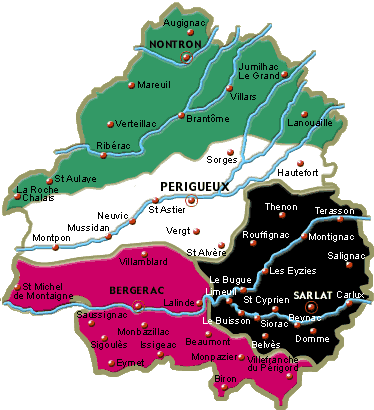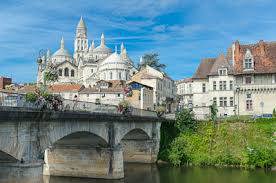The Dordogne

The Four Regions of Perigord

Perigueux - Prefecture of Dordogne

Walnuts are crucial to the economy of the area
History of the Dordogne:
The department of the Dordogne is located in the French region of Nouvelle-Aquitaine between the Loire Valley and the Pyrenees, and is named after the great Dordogne river that runs through it. The current boundaries ‘roughly’ correspond with the ancient county of Perigord. The Prefecture (capital) of the region is Perigueux.
The area is famous world wide for its local produce which includes walnuts, you will see many walnut trees at La Roussille and in the surrounding area, foie gras, wine and truffles.
The county of Perigord dates back to when the area was inhabited by the Gauls, a celtic race who populated the area through the Iron Age and Roman period. The area eventually became known as the county of Le Périgord and its inhabitants became known as the Périgordins.
There are four Périgords in the Dordogne. The "Périgord Vert" (Green Périgord) with its main town of Nontron. This consists of verdant green valleys in a region crossed by many rivers and streams and this is the area that La Roussille is situated in. The "Périgord Blanc" (White Périgord) situated around the department's capital of Périgueux is a limestone plateaux with wide valleys and meadows. The "Périgord Pourpre" (Purple Périgord) with its capital of Bergerac is a wine region and finally the "Périgord Noir" (Black Périgord) surrounding the administrative centre of Sarlat, overlooking the valleys of the Vézère and the Dordogne, where the woods of oak and pine give it its name.
The area has had a turbulent past with many bloody battles scarring the landscape. The Gauls made up of four different tribes took part in the resistance against Rome. Concentrated in a few major sites across the region are the remains of the Gallo-Roman period (the ruined tower and arenas in Périgueux (formerly Vesone), the Périgord museum's archaeological collections, villa remains in Montcaret and the Roman tower of La Rigale Castle in Villetoureix). The earliest artificial caves, either above or below ground, can be found throughout the Dordogne. These subterranean refuges and lookout huts were large enough to shelter entire local populations with Julius Caesar claiming the Gauls took refuge in these caves during the resistance.
After a large part of what is now Nouvelle-Aquitaine was transferred to the English Crown under the Plantagenets following the remarriage of Eleanor of Aquitaine in 1152 to Henry II of England, Périgord passed by right to English sovereignty. Being situated at the boundaries of influence of the monarchies of France and England, it oscillated between the two dynasties for more than three hundred years of struggle until the end of the Hundred Years' War in 1453. The county had been torn apart and, as a consequence, that has modelled the area that you see today.
During the calmer periods of the late 15th and early 16th centuries, the banks of the Dordogne saw urban development with the finest Gothic and Renaissance residences being built in Périgueux, Bergerac and Sarlat. In the countryside, the nobility ruled more than 1200 chateaux, manors and country houses that were erected. In the second half of the sixteenth century however, the terrors of war again visited the area, as the attacks, pillaging and fires of the Wars of Religion reached a rare degree of violence in Périgord. At the time, Bergerac was one of the most powerful Huguenot (French Protestant) strongholds, along with La Rochelle. Following these wars, Henry of Navarre (Henry IV of France) was to return to the Crown for good but would continue to suffer from the sudden political changes of the French nation, from the Revolution to the tragic hours of the Resistance.
Whilst there is no doubting its troubled past, this colourful history has been the sole reason that the region is peppered with castles, chateaux, churches, bastide towns and cave fortresses, beautiful sites that we hold dear today. Thankfully the Dordogne is a much more peaceful place today and has beauty wherever you look be it natural or man made.
